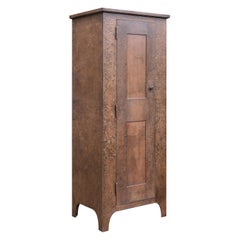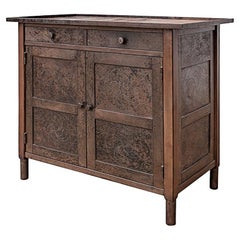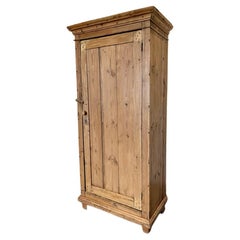Pennsylvania House Armoire
Early 2000s American Shaker Wardrobes and Armoires
Steel
People Also Browsed
Early 2000s American Shaker Bookcases
Steel
20th Century French Wardrobes and Armoires
Wood
Vintage 1960s Belgian Mid-Century Modern Wardrobes and Armoires
Wood
Antique 19th Century Coat Racks and Stands
Bentwood
Antique 1850s French Louis Philippe Wardrobes and Armoires
Steel
Antique Early 18th Century Dutch Renaissance Blanket Chests
Oak
Antique Early 19th Century English William IV Wardrobes and Armoires
Mahogany
Antique 1780s Dutch Rococo Cabinets
Walnut
Early 20th Century Austrian Vienna Secession Wardrobes and Armoires
Mirror, Oak, Pine
Antique 19th Century Wardrobes and Armoires
Pine
Antique Early 19th Century German Biedermeier Wardrobes and Armoires
Softwood, Walnut
Antique 1840s Italian Louis Philippe Wardrobes and Armoires
Poplar
Vintage 1920s Dutch Art Deco Cabinets
Glass, Macassar, Oak
Early 2000s American Mid-Century Modern Dressers
Steel
Antique Mid-19th Century Austrian Neoclassical Wardrobes and Armoires
Oak
Antique 19th Century Wardrobes and Armoires
Cedar
Jim Rose for sale on 1stDibs
Bringing lively newness to weathered and worn found materials, artist and furniture designer Jim Rose mined scrap heaps and junkyards for the metal he used in his furniture, collages and decorative objects. He kept his eyes open for the ideal scraps of aged steel that could be bent and shaped into a base, frame or surface of his next piece, hand-picking off-colored bits to serve as inlays and accents.
Rose was long associated with the American Studio Craft movement, and many of his one-of-a-kind works can typically be characterized as a venturesome fusion of folk art and modernist design. Each piece, crafted by hand and with fastidious care in his Wisconsin studio, is representative of his work ethic and boundless imagination.
Born in Indiana, Rose studied briefly at Bard College in New York City and earned his BFA in sculpture from the School of the Art Institute of Chicago in 1988. A couple of years earlier, he established his design studio, along with his wife Suzanne — an award-winning photographer — as his partner. During the 1990s, Rose and Suzanne traveled the American Northeast, where he became enamored with Shaker furniture.
When Rose returned home, he read every piece of literature he could about the history of the Shakers. The name derives from the popular moniker for an all-but-vanished American religious sect, whose members crafted honest, modest household furniture and objects as part of their belief in purposeful living and simplicity in all things. Rose incorporated Shaker methods into the production of his own designs. Rather than utilize the unpretentious hardwoods that the Shakers preferred, however, Rose worked with discarded materials, fashioning tables, case pieces and decorative objects from repurposed steel and other metals.
In the late 1990s, Rose began to include multi-colored metal into his works — adapting methods used by colonial quiltmakers. His furnishings began to take on a mosaic look, bringing a substantial amount of visual appeal and new charm to each of his distinctive creations. Rose also produced a body of work that drew on Ming dynasty designs.
With numerous showings at Sculpture Objects & Functional Art Fair in New York City and Chicago, Rose made a name for himself throughout the late 1990s and early 2000s. He had solo and group exhibitions throughout his career, including in Palm Beach, Florida, and Mesa, Arizona — as well as at many other galleries in New York and Chicago. Rose’s work is held in the collections of the Smithsonian American Art Museum, Mesa Contemporary Arts, Racine Art Museum and other institutions.
On 1stDibs, find a collection of vintage Jim Rose storage cabinets, tables, and decorative objects.
A Close Look at shaker Furniture
Authentic Shaker furniture is hard to come by, but not exceedingly rare. “Shaker style” describes furnishings and interiors that are both warm and simple, centered on unpretentious wooden chairs, tables and cabinets without ornament or embellishment.
The term derives from the popular name for an all-but-vanished American religious sect, whose members crafted honest, modest household furniture and objects as part of their belief in purposeful living and simplicity in all things.
Members of the United Society of Believers in Christ’s Second Appearing — called Shakers, derisively, because they writhed and danced in religious ecstasy during worship — arrived in the United States from England in 1774. Within 50 years, the sect had established 19 self-sufficient communities from Maine to Kentucky, where they lived pure, humble and industrious lives. The furniture and objects the Shakers made reflected their strict rules of behavior. Pieces such as ladder- and slat-back chairs and trestle tables were painstakingly crafted from native woods like maple and cherry, using traditional methods such as mortise-and-tenon and dovetail joinery and lathe turning. They employed strong, straight lines and symmetrical proportions, and decoration of any kind — carving, veneers, inlays — was prohibited, as it would encourage the sins of pride and vanity.
The Shakers movement included some 6,000 members at its peak in the 1860s, but the group practiced celibacy and could attempt to sustain their flock only by recruiting new adherents. Modernity proved too alluring. Today only one tiny Shaker community, in Maine, still exists, though the sect’s heritage is preserved at several historical sites.
To support their communities, the Shakers sold furniture to outsiders, who appreciated its superb quality. While the “Shaker style” label is today given to many plain, simple wooden pieces, it should also denote superior construction and solid materials. As elements in interior design, Shaker furnishings work best in a quiet decor. Modest pieces such as these can become lost among more ornate works. The style is most suitable to a country home — although a Shaker chair or cabinet can make a striking counterpoint in a modernist, urban setting.
As you will see on 1stDibs, Shaker furniture and objects have a deep appeal for their warmth, honesty and graceful simplicity, which make them welcome almost anywhere.
Finding the Right cupboards for You
In any kitchen, dining room or other area of your home, antique and vintage cupboards can help you organize your space as well as support your endeavors to show off your prized collectibles and decorative objects.
Cupboards have long been staples in interior design as reliable and versatile case pieces, which have been a vital part of the home for centuries. Cupboards appeared in the Middle Ages and by the 17th century had eclipsed the chest in popularity as a piece of furniture for storage. New techniques in woodworking allowed furniture manufacturers to build pieces that were more complex than simple chests.
Early cupboards were often tall and were typically used to store linens. By the 18th century, there was more variety in the available shapes and sizes, with some pieces combining a chest of drawers with a tall cabinet.
Cupboards became large and heavy as their importance as furniture grew, frequently making them the biggest piece in a home. They could involve decorative elements like columns and cornices. Over the years, more features were added by furniture makers, such as glass panels for displaying items like porcelain ware.
Besides keeping the room tidy, a cupboard can set the tone through its size. Antique and vintage cupboards are built to last, and, with centuries of design choices, these structures are easy to match with existing furniture.
On 1stDibs, find a range of options for your home including new and custom cupboards, mid-century modern cupboards and original creations, like the weave quilt cupboards by Jim Rose. Contemporary cupboards with unexpected shapes and colors can add an element of surprise to a room. They also provide versatile storage while creating a modern effect.


